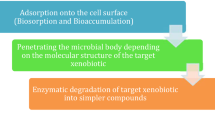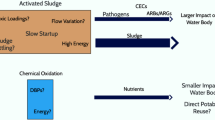Abstract
The biological degradation of volatile halogenated hydrocarbons (chlorocarbons (VCCs) and chlorofluorocarbons (CFCs)) was investigated under simulated conditions of landfills in laboratory test digesters. Fully halogenated VCCs (tetrachloroethylene, 1,1,1-trichloroethane, tetrachloromethane and dichloromethane) and CFCs (trichlorofluoromethane (R11), dichlorodifluoromethane (R12) and 1,1,2-trichlorotrifluoroethane (R113)) were degraded under anaerobic conditions in addition to the methanogenic bacteria in municipal solid waste (MSW) and organic wastes. These substances showed different degradation reactions in the simulated acid and methanephases of MSW landfills. It is assumed that R11 and R113 could be decomposed completely under methanogenic conditions. Dichlorofluoromethane (R21) was oberved as the reductive degradation product of R11 and was further degraded during the methanephase, but hardly at all under acid conditions. Chlorodifluoromerhane (R22) as a degradation product of R12 was not degraded, even not in the methanephase. In the acidphase, R11 was the only CFC to be dechlorinated, although only in small quantities. The degradation products of tetrachloroethylene differed under the various environmental conditions. In the acidphase, 1,1-dichloroethylene was detected as the only dichloroethylene, whereas in particular cis-1,2-dichloroethylene but also trans-1,2-dichloroethylene, 1,1-dichloroethylene and vinyl chloride could be detected as metabolites in the methanephase. Dichloromethane and chloroethane, as metabolites of 1,1,1-trichloroethane, could hardly be degraded at all in the acidphase. The degradation of VCCs and CFCs is largely independent of the substrate used. The investigations have demonstrated that the measured biodegradation rates (0.3–15 mg/m3 material vol./h) cannot be improved considerably since they are limited by the inhibiting effect of the substances and their degradation products.
Similar content being viewed by others
References
Anonymous (1992): Alternativen zu FCKW und Halonen — Technologien und Ersatzstoffe. (Alternatives to CFC and Halon — Technologies and substitutes). Internationale Konferenz, 24.–26. Februar 1992, Berlin
Bagley, D.M.;J.-M. Gossett (1990): Tetrachloroethylene Transformation to Trichloroethylene and cis-1,2-Dichloroethylene by Sulfate-Reducing Enrichment Cultures. Applied and Environmental Microbiology56/ 8, 2511–2516
Christensen, T.H.; P.H. Nielsen; P.L. Bjerg (1995): Degradation of organic chemicals in a leachate pollution plume: An in-situ experiment. Proceedings Sardinia 95, Fifth International Landfill Symposium, Cagliari, Italy; 2–6 October 1995
Chaudry, G.R.;S. Chapalamadugu (1991): Biodegradation of halogenated organic compounds. Microbiological Reviews55/1, 59–79
Deipser, A.;R. Stegmann (1994): The Origin and Fate of Volatile Trace Components in Municipal Solid Waste Landfills. Waste Management & Research12, 129–39
Deipser, A.;R. Stegmann (1993): Untersuchungen von Hausmüll auf leichtflüchtige Spurenstoffe (Investigations of volatile trace components in municipal solid waste). Müll und Abfall2/93, 69–81
Denovan, B.A. (1992): Biological degradation of chlorofluorocarbons in anaerobic environments. Chemosphere24/7, 935–940
Egli, C.;T. Tschan;R. Scholtz;E.M. Cook;T. Leisinger (1988): Transformation of Tetrachloromethane to Dichloromethane and Carbon Dioxide byAcetobacterium woodii. Applied and Environmental Microbiology54/11, 2819–2824
Fathepure, B.Z.;S.A. Boyd (1988): Dependence of Tetrachloroethylene Dechlorination on Methanogenic Substrate Consumption byMethanosarcina sp. Strain DCM. Applied and Environmental Microbiology54/ 12, 2976–2980
Haderlein, S.;K. Pecher (1988): Mobility of Chlorofluorocarbons in Deposits of Shredder Wastes from Plastic and Metal Utilizing Industries. Water, Air and Soil Pollution37, 459–464
Hanson, R.S.;H.C. Tsien;K. Tsuji;G.A. Brusseau;L.P. Wackett (1990): Biodegradation of low-molecularweight halogenated hydrocarbons by methanotrophic bacteria. FEMS Microbiology Reviews8, 273–278
Kästner, M. (1991): Reductive dechlorination of triund tetrachlorethylenes depends on transition from aerobic to anaerobic conditions. Applied Environmental Microbiology57/7, 2039–2046
Krone, U.E.;R.K. Thauer (1992): Dehalogenation of trichlorofluoromethane (CFC-11) by Methanosarcina Barkeri. FEMS Microbiology Letters90, 201–204
Krone, U.E.;K. Thauer;H.P.C. Hogenkamp;K. Steinbach (1991): Reductive Formation of Carbon Monoxide from CC14 and FREONs 11, 12, and 13 Catalyzed by Corrinoids. Biochemistry30, 2713–2719
Laugwitz, R. (1990): Deponiegase als Quelle halogenierter Kohlenwasserstoffe (Landfill gas as a source of halogenated hydrocarbons). Müll und Abfall3/90, 142–151
Lovley, D.R.;J.C. Woodward (1992): Consumption of Freons CFC-11 and CFC-12 by Anaerobic Sediments and Soils. Environment Science and Technology26/5, 925–929
Müller, R.;F. Lingens (1987): Mechanismen der mikrobiellen Dehalogenierung von Chlorkohlenwasserstoffen (Mechanisms of Microbial Dehalogenations of Chlorinated Hydrocarbons). GIT Supplement — Umweltanalytik Umweltschutz5, 4–9
Neilson, A.H. (1990): The biodegradation of halogenated organic compounds. Journal of Applied Microbiology69/4, 445–470
Poller, T. (1990): Hausmüllbürtige LCKW/FCKW und deren Wirkung auf die Methangasbildung, Hamburger Berichte (VCCs/CFCs from domestic wastes and their function on the methane gas production). No. 2, Economica Verlag, Bonn
Stegmann, R.; A. Deipser; H. Woyczechowski (1994): Untersuchungen zum Verhalten von ausgewählten organischen Schadstoffen unter kontrollierten Deponiemilieubedingungen in Laborlysimetern (Investigations on the behaviour of selected organic contaminants under controlled landfill milieu conditions in laboratory lysimeters). DFG-Abschlußbericht (unpublished)
Stegmann, R. (1981): Beschreibung eines Verfahrens zur Untersuchung anaerober Umsetzungsprozesse von festen Abfallstoffen im Labormaßstab (Description of a procedure to investigate anaerobic degradation processes with solid waste materials on a laboratory scale). Müll und Abfall2, 35–39
Stromeyer, S.A.;W. Winkelbauer;H. Kohler;A.M. Cook;T. Leisinger (1991): Dichloromethane utilized by an anaerobic mixed culture: acetogenesis and methanogenesis. Biodegradation2, 129–137
Vogel, T. M.;P.L. McCarty (1985): Biotransformation of tetrachloroethylene to trichloroethylene, dichloroethylene, vinyl chloride, and carbon dioxide under methanogenic conditions. Applied and Environmental Microbiology5, 1080–1083
Author information
Authors and Affiliations
Rights and permissions
About this article
Cite this article
Deipser, A., Stegmann, R. Biological degradation of VCCs and CFCs under simulated anaerobic landfill conditions in laboratory test digesters. Environ. Sci. & Pollut. Res. 4, 209–216 (1997). https://doi.org/10.1007/BF02986348
Received:
Accepted:
Issue Date:
DOI: https://doi.org/10.1007/BF02986348




